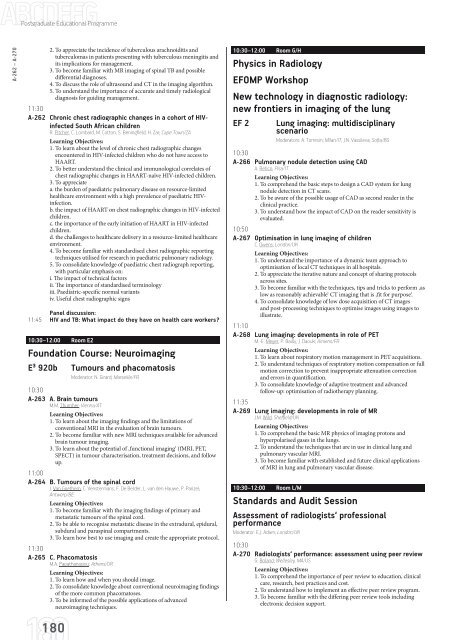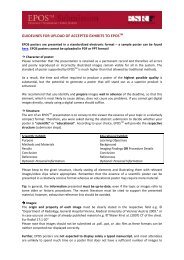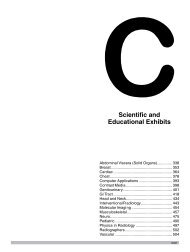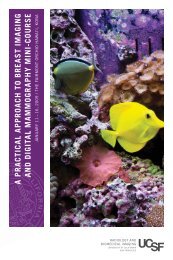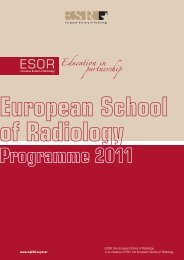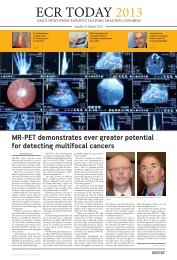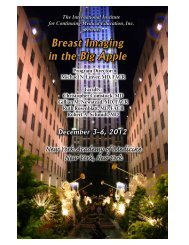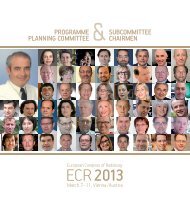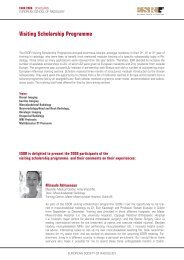ECR 2013 â Final Programme - myESR.org
ECR 2013 â Final Programme - myESR.org
ECR 2013 â Final Programme - myESR.org
- No tags were found...
Create successful ePaper yourself
Turn your PDF publications into a flip-book with our unique Google optimized e-Paper software.
Postgraduate Educational <strong>Programme</strong>A-262 – A-2702. To appreciate the incidence of tuberculous arachnoiditis andtuberculomas in patients presenting with tuberculous meningitis andits implications for management.3. To become familiar with MR imaging of spinal TB and possibledifferential diagnoses.4. To discuss the role of ultrasound and CT in the imaging algorithm.5. To understand the importance of accurate and timely radiologicaldiagnosis for guiding management.11:30A-262 Chronic chest radiographic changes in a cohort of HIVinfectedSouth African childrenR. Pitcher, C. Lombard, M. Cotton, S. Beningfield, H. Zar; Cape Town/ZALearning Objectives:1. To learn about the level of chronic chest radiographic changesencountered in HIV-infected children who do not have access toHAART.2. To better understand the clinical and immunological correlates ofchest radiographic changes in HAART-naïve HIV-infected children.3. To appreciatea. the burden of paediatric pulmonary disease on resource-limitedhealthcare environment with a high prevalence of paediatric HIVinfection.b. the impact of HAART on chest radiographic changes in HIV-infectedchildren.c. the importance of the early initiation of HAART in HIV-infectedchildren.d. the challenges to healthcare delivery in a resource-limited healthcareenvironment.4. To become familiar with standardised chest radiographic reportingtechniques utilised for research in paediatric pulmonary radiology.5. To consolidate knowledge of paediatric chest radiograph reporting,with particular emphasis on:i. The impact of technical factorsii. The importance of standardised terminologyiii. Paediatric-specific normal variantsiv. Useful chest radiographic signsPanel discussion:11:45 HIV and TB: What impact do they have on health care workers?10:30–12:00 Room E2Foundation Course: NeuroimagingE³ 920b Tumours and phacomatosisModerator: N. Girard; Marseille/FR10:30A-263 A. Brain tumoursM.M. Thurnher; Vienna/ATLearning Objectives:1. To learn about the imaging findings and the limitations ofconventional MRI in the evaluation of brain tumours.2. To become familiar with new MRI techniques available for advancedbrain tumour imaging.3. To learn about the potential of ‚functional imaging‘ (fMRI, PET,SPECT) in tumour characterisation, treatment decisions, and followup.11:00A-264 B. Tumours of the spinal cordJ. Van Goethem, C. Venstermans, F. De Belder, L. van den Hauwe, P. Parizel;Antwerp/BELearning Objectives:1. To become familiar with the imaging findings of primary andmetastatic tumours of the spinal cord.2. To be able to recognise metastatic disease in the extradural, epidural,subdural and paraspinal compartments.3. To learn how best to use imaging and create the appropriate protocol.11:30A-265 C. PhacomatosisM.A. Papathanasiou; Athens/GRLearning Objectives:1. To learn how and when you should image.2. To consolidate knowledge about conventional neuroimaging findingsof the more common phacomatoses.3. To be informed of the possible applications of advancedneuroimaging techniques.18010:30–12:00 Room G/HPhysics in RadiologyEFOMP WorkshopNew technology in diagnostic radiology:new frontiers in imaging of the lungEF 2 Lung imaging: multidisciplinaryscenarioModerators: A. Torresin; Milan/IT, J.N. Vassileva; Sofia/BG10:30A-266 Pulmonary nodule detection using CADA. Retico; Pisa/ITLearning Objectives:1. To comprehend the basic steps to design a CAD system for lungnodule detection in CT scans.2. To be aware of the possible usage of CAD as second reader in theclinical practice.3. To understand how the impact of CAD on the reader sensitivity isevaluated.10:50A-267 Optimisation in lung imaging of childrenC. Owens; London/UKLearning Objectives:1. To understand the importance of a dynamic team approach tooptimisation of local CT techniques in all hospitals.2. To appreciate the iterative nature and concept of sharing protocolsacross sites.3. To become familiar with the techniques, tips and tricks to perform ‚aslow as reasonably achievable‘ CT imaging that is ‚fit for purpose‘.4. To consolidate knowledge of low dose acquisition of CT imagesand post-processing techniques to optimise images using images toillustrate.11:10A-268 Lung imaging: developments in role of PETM.-E. Meyer, P. Bailly, J. Daouk; Amiens/FRLearning Objectives:1. To learn about respiratory motion management in PET acquisitions.2. To understand techniques of respiratory motion compensation or fullmotion correction to prevent inappropriate attenuation correctionand errors in quantification.3. To consolidate knowledge of adaptive treatment and advancedfollow-up: optimisation of radiotherapy planning.11:35A-269 Lung imaging: developments in role of MRJ.M. Wild; Sheffield/UKLearning Objectives:1. To comprehend the basic MR physics of imaging protons andhyperpolarised gases in the lungs.2. To understand the techniques that are in use in clinical lung andpulmonary vascular MRI.3. To become familiar with established and future clinical applicationsof MRI in lung and pulmonary vascular disease.10:30–12:00 Room L/MStandards and Audit SessionAssessment of radiologists‘ professionalperformanceModerator: E.J. Adam; London/UK10:30A-270 Radiologists‘ performance: assessment using peer reviewG. Boland; Wellesley, MA/USLearning Objectives:1. To comprehend the importance of peer review to education, clinicalcare, research, best practices and cost.2. To understand how to implement an effective peer review program.3. To become familiar with the differing peer review tools includingelectronic decision support.


